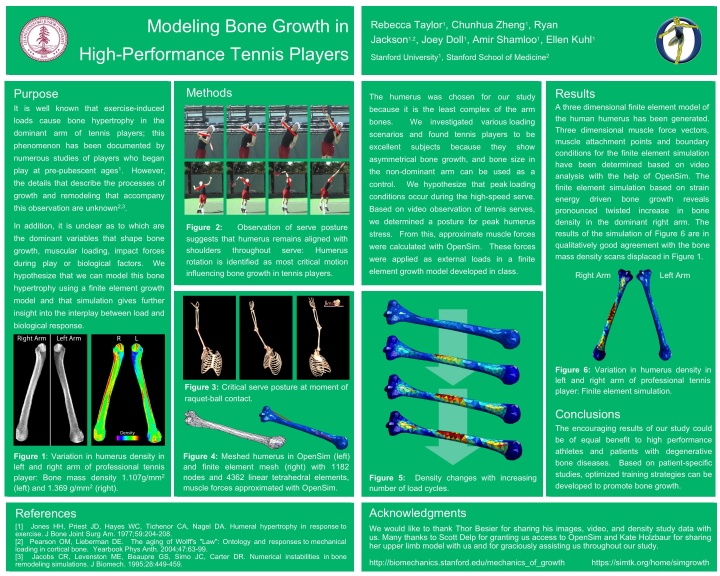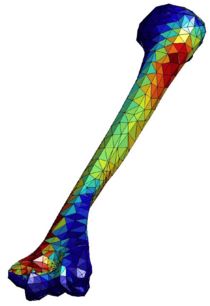Contents |
mechanics of growth
me 337 - mechanics of growth
spring 2007
tue thu 3:15-4:30
mc cullough 126
class paper
taylor re, zheng ch, jackson pr, doll jc, chen jc, holzbaur krs, besier t, kuhl e. the phenomenon of twisted growth: humeral torsion in dominant arms of high performance tennis players. comp meth biomech biomed eng, in press, 2009;12:83-93. (download)
final project
taylor re, zheng ch, jackson pr, doll jc, chen jc, holzbaur krs, besier t, kuhl e. the phenomenon of twisted growth: humeral torsion in dominant arms of high performance tennis players. 16th annual symposium on computational methods in orthopaedic biomechanics, san francisco, california, 2008 (download)
taylor re, zheng ch, jackson pr, doll jc, chen jc, holzbaur krs, besier t, kuhl e. critical loading during serve: modeling stress-induced bone growth in performance tennis players. SBC2008-192005. proceedings of the ASME 2008 summer bioengineering conference, marco island, florida, 2008 (download)
goals
in contrast to traditional engineering structures living structures show the fascinating ability to grow and adapt their form, shape and microstructure to a given mechanical environment. this course addresses the phenomenon of growth on a theoretical and computational level and applies the resulting theories to classical biomechanical problems like bone remodeling, hip replacement, wound healing, atherosclerosis or in stent restenosis. this course will illustrate how classical engineering concepts like continuum mechanics, thermodynamics or finite element modeling have to be rephrased in the context of growth. having attended this course, you will be able to develop your own problem-specific finite element based numerical solution techniques and interpret the results of biomechanical simulations with the ultimate goal of improving your understanding of the complex interplay between form and function.
syllabus
| day | date | topic | slides | homework | |
|---|---|---|---|---|---|
| tue | apr | 03 | introduction - different forms of growth | s01 | h01 wiki growth |
| thu | apr | 05 | tensor calculus - tensor algebra | s02 | |
| tue | apr | 10 | tensor calculus - tensor analysis | s03 | h02 tensors |
| thu | apr | 12 | kinematic equations - growth | s04 | |
| tue | apr | 17 | balance equations – closed systems | s05 | |
| thu | apr | 19 | balance equations – open systems | s06 | example rocket propulsion |
| tue | apr | 24 | constitutive equations – density growth | s07 | example astronaut |
| thu | apr | 26 | finite element method – density growth theory | s08 | |
| tue | mai | 01 | finite element method – density growth matlab | s09 | matlab density |
| thu | mai | 03 | examples – density growth | s10 | example bone |
| tue | mai | 08 | class project - growth of tennis player arms | s11 | |
| thu | mai | 10 | finite element method – density growth alternative | s12 | |
| tue | mai | 15 | constitutive equations – volume growth | s13 | example tumor growth |
| thu | mai | 17 | finite element method - volume growth theory | s14 | |
| tue | mai | 22 | finite element method - volume growth matlab | s15 | |
| thu | mai | 24 | examples - volume growth | s16 | h03 wiki growth |
| tue | mai | 29 | examples - remodeling | s17 | |
| thu | mai | 31 | class project - growth of tennis player arms | s18 | |
| tue | jun | 05 | class project - discussion, presentation, evaluation |
class project - tennisplayers
motivation - density measurements of tennisplayer arms in thor besier's lab
first results of the tennisplayer project
| here's the current state of the tennis player arm density project: bex generated a finite element mesh from the humerus surface data that she got from simbios through the open source simTK neuromuscular biomechanics page. cool! sorry ryan, this seems to be a male tennis player ;-( we've got two meshes, a coarse one and a fine one, modify the in_humer.m file to load either of the two. you might want to start with the coarse mesh data_hum1_elm.dat and data_humr1_nod1.dat. you can now download all the matlab files from matlab_bone.tar.gz and just change the input line from the femur to the humerus in the main file nlin_fem.m. the figure on the left has been generated by just applying three load steps, so far it's been just tension in the y-direction. with the help of kate holzbaur from scott delp's neuromuscular biomechanics lab, bex and ryan have determined the muscle forces during the serve in a fully three dimensional setting to load the humerus with the relevant forces and elaborate whether it grows in a twisted way. |
here's the related literature you found: p00 ryan jackson, p01 p02 p03 p04 rebecca taylor, p05 p06 p07 p08 p09 p10 p11 p12 p13 p14 chun hua zheng, p15 nathaniel benz, p16 p17 p18 p19 p20 p21 julia chen, p22 joey doll, p23 amir shamloo
matlab files
voila!... just to get used to tensor notation and matlab
matlab_ex01.m ... the one with all the tensors
finally... here's the matlab nonlinear finite element code for density growth in bone!
matlab_bone.tar.gz ... the one where u got it all
or... if you prefer to look @all the individual files
i've tried to put comments to most of the variables, send me an email if you want moooore ;-)
nlin_fem.m ... the one and only
extr_dof.m ... the one which extracts element information from the global
field
assm_sys.m ... the one with the strange big A operator
res_norm.m ... the one which tells you how far you are away from your ultimate goal
solve_nr.m ... the one with the solution to all problems
plot_int.m ... the one to plot internal variables on the spatial/deformed configuration
plot_mat.m ... the one to plot the material/undeformed configuration
quads_2d.m ... the one with the 2d quadrillateral element
tetra_3d.m ... the one with the 3d tetrahedral element
brick_3d.m ... the one with the 3d brick element
cnst_den.m ... the one with the constitutive equations for density growth
cnst_vol.m ... the one with the constitutive equations for volume growth
updt_den.m ... the one with yet another newton iteration to calculate the dnsity
updt_vol.m ... the one with yet another newton iteration to calculate the volume
ex_humer.m ... the one with the example of the 3d humerus
ex_femur.m ... the one with the example of the 2d femur
ex_bimat.m ... the one with the idealized humerus of cortical and trabecular bone
ex_cylin.m ... the one with the idealized humerus of trabecular bone
ex_tubes.m ... the one with the idealized humerus of cortical bone
ex_beams.m ... the one with the example of a beam
ex_punch.m ... the one with the example of a 3d punch
ex_block.m ... the one with the example of a 3d block
ex_frame.m ... the one with the example of the 2d frame structure
ex_unity.m ... the one with the example of two 2d elements
mesh_sqr.m ... the one which meshes a square domain
num_grid.m ... the other one from bex (thanx!)
in_humer.m ... the one from bex to read the humerus input
data_humr1_elm.dat ... the coarse one with the humerus elements
data_humr1_nod.dat ... the coarse one with the humerus coordinates
data_humr2_elm.dat ... the fine one with the humerus elements
data_humr2_nod.dat ... the fine one with the humerus coordinates
in_femur.m ... the one from bex to read the femur input
data_femur_elm.dat ... the one with all the femur elements
data_femur_nod.dat ... the one with all the femur coordinates
bone example
| for those of you who are interested in calculating the bone example from the literature (2) and (3), bex converted the bone file (you're awesome! thanx!) and now you could all run the bone with matlab! just download the gzipped archive above, unpack it, call the main file nlin_fem and type step,,50 to run 50 time steps to allow for density redistribution. you should then obtain the figure on the left... just throw me an email if it doesn't work! ... and yes, i know... the code's slow... so go'n get a cup of coffee... or try to re-code cnst_den.m in terms of either spatial or material stresses & tangents by using voigt's matrix notation and speed up quads_2d.m by using the traditional old-fashioned b-operator, it's maybe ugly in the code but a loaaad faster! |
additional reading
don't feel forced to read all of this! it's just additional information that some of you might want to look at!
(1) taylor re, zheng c, jackson rp, doll jc, chen jc, holzbaur krs, besier t, kuhl e: the phenomenon of twisted growth: humeral torsion in dominant arms of high performance tennis players, submitted for publication 2007
(2) taber l: biomechanics of growth, remodeling, and morphogenesis, appl mech rew 48, 487-545, 1995
(3) jacobs, cr, levenston me, beaupre gs, simo jc, carter dr: numerical instabilities in bone remodeling simulations: the advantages of a node-based finite element approach, j biomechanics 28, 449-459, 1995
(4) kuhl e, menzel a, steinmann p: computational modeling of growth - a critical review, a classification and two new consistent approaches, computational mechanics 32, 71-88, 2003
(5) rodriguez ek, hoger a, mc culloch a: stress-dependent finite growth in soft elastic tissues, j biomechanics 27, 455-467, 1994
(6) kuhl e, maas r, himpel g, menzel a: computational modeling of arterial wall growth - attempts towards patient-specific simulations based on computer tomography, biomech model mechanobiol, available online first, DOI 10.1007/s10237-006-0062-x
teaching evaluation
thanks for your patience! i promise to improve on this...
thanx! i really do appreciate your input and comments!


